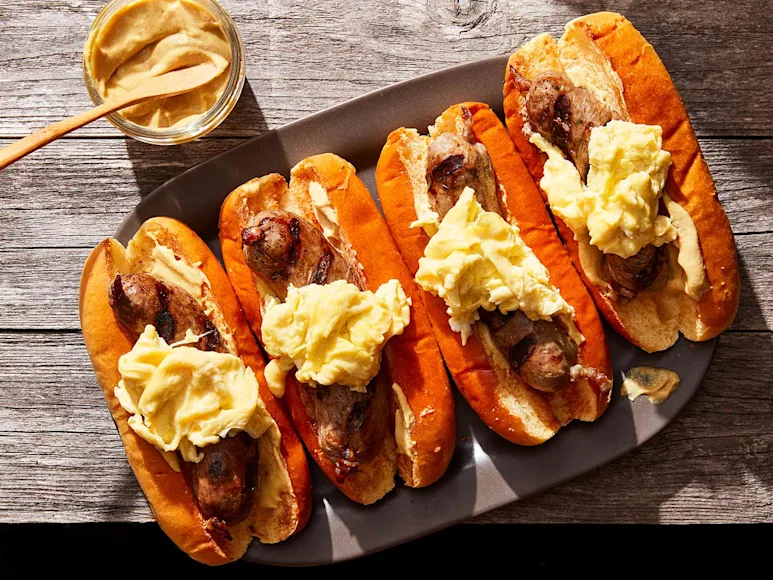
Can you imagine a more appetizing meal to come home to after a hunt than this venison breakfast sausage sandwich? Photographs by Christopher Testani/Food and Prop Styling by Roscoe Betsill
Whether you hunt deer, elk, waterfowl, wild hogs, or small game, chances are, you already have all you need to make delicious wild-game sausage in your freezer and spice cabinet. The sausage recipes that follow aren’t difficult to master, and each one is sure to be a crowd-pleaser, be it at home or at hunting camp. So, break out the grinder (and maybe a six-pack) and invited a couple buddies over to help you crank out a batch of the best-tasting wild-game sausages you’ve ever had.
Chimichurri Goose (or Duck) Sausage

Don’t know scrambled eggs as a sausage topper til you’ve tried this recipe. Photographs by Christopher Testani/Food and Prop Styling by Roscoe Betsill
Ingredients
5 lb. skinless goose (or duck) breast
3 lb. beef fat
10 garlic cloves, minced
5 Tbsp. salt
3 Tbsp. freshly ground black pepper
1 Tbsp. chile flakes
3 cups shallot, minced
1 cup olive oil
2 bunches parsley, finely chopped
1 cup red wine vinegar, chilled
Hog casings, soaked in water
Directions
1. Cut the breast meat and beef fat into 2-inch cubes. Place the meat in a bowl, add the garlic, salt, pepper, and chile flakes, and mix. Let the meat marinate in the refrigerator for at least 2 hours and up to 24 hours.
2. Before you grind the meat, place all of the metal components of your meat grinder and a large bowl in the freezer for about 30 minutes.
3. Grind the meat through a medium die into the chilled bowl. Next, add the shallots, olive oil, parsley, and red wine vinegar to the ground meat, and mix the ingredients thoroughly with your hands.
4. Emulsify the sausage: Add about 2 cups of ice water, a bit at a time, to the ground meat, and mix vigorously with your hands. Depending on the coarseness of the grind and the protein, this process can take anywhere from 5 to 10 minutes, and your hands will ache from the cold. You’ll know the mixture has emulsified when the meat takes on a tacky texture and begins to stick to the sides of the bowl. Cook a small patty of the sausage, then adjust the seasoning as needed. Let the meat rest, covered, for an hour in the refrigerator. Place the metal grinder components back in the freezer.
5. Stuff the meat into the casings, forming 4- to 5-inch links. Prick any air bubbles in the sausage with the point of a paring knife. Place the sausages on a sheet pan and let them sit, uncovered, in the refrigerator overnight. At this point, you can snip the casing between each link, and the sausage can be cooked or frozen.
OK, my honkers are linked. How should I cook them?
I like to prepare this sausage in a riff on a choripan, an Argentine street sandwich that I tried on a hunting trip in South America last year. Grill the sausages over coals, then serve them in toasted buns topped with scrambled eggs and Dijon mustard. —J.P.B.
Maple Venison Breakfast Sausage
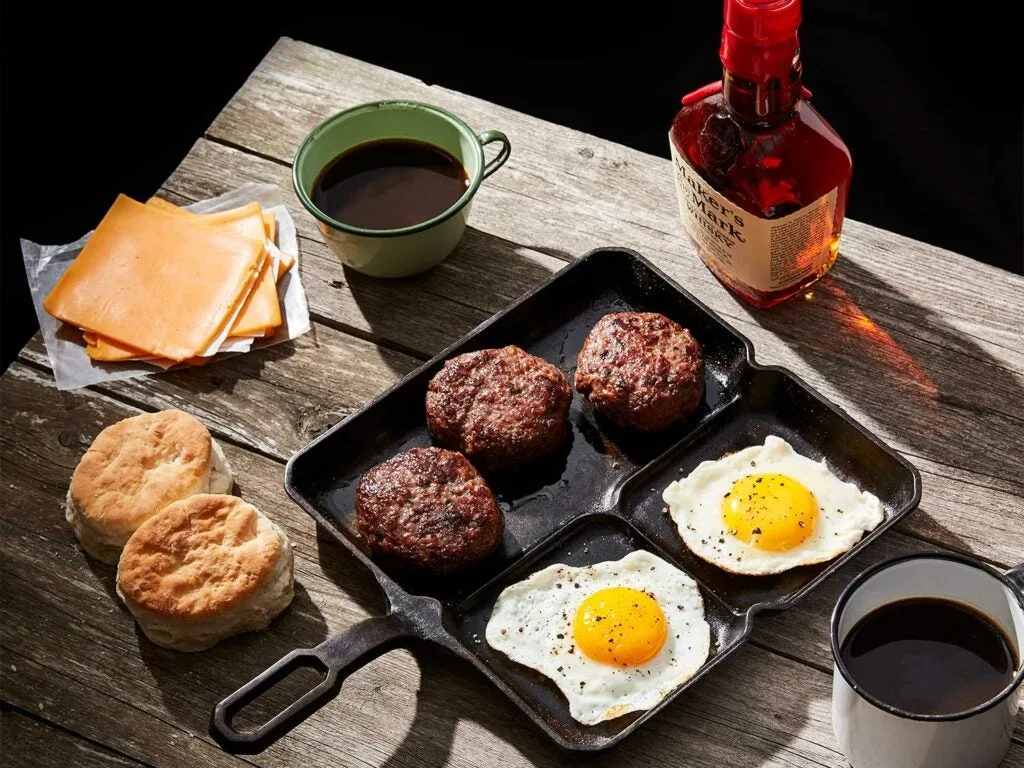
Our sweet-and-savory maple venison sausage is the breakfast of champions. Photographs by Christopher Testani/Food and Prop Styling by Roscoe Betsill
Ingredients
5 lb. venison
2 lb. bacon
4 Tbsp. salt
3 Tbsp. freshly ground black pepper
3 Tbsp. dried sage
1 Tbsp. chile flakes
2 cups maple syrup
Directions
1. Cut the venison and bacon into 2-inch cubes. Place the meat into a bowl, add the salt, pepper, sage, and chile flakes, and mix. Let the meat marinate in the refrigerator for at least 2 hours and up to 24 hours.
2. Before you grind the meat, place all of the metal components of your meat grinder and a large bowl in the freezer for about 30 minutes.
3. Grind the meat through a medium die into the chilled bowl. Add the maple syrup, and mix thoroughly with your hands.
4. Emulsify the sausage: Add about 2 cups of ice water, a bit at a time, to the meat, and mix vigorously with your hands for 5 to 10 minutes, or until the meat takes on a tacky texture and begins to stick to the sides of the bowl. Cook a small patty of the sausage and adjust the seasoning as needed. Let the meat rest, covered, for an hour in the refrigerator.
5. Portion the sausage into 3- to 4-ounce patties, and freeze or eat fresh within the next 5 days.
What’s the best way to serve this?
After a duck hunt, I’m craving a breakfast sandwich and a coffee, spiked with Maker’s Mark. Cook the sausage in a skillet, and serve it on a biscuit with American cheese and a fried egg. —J.P.B.
Jalapeño and Cheese Boar Bratwurst
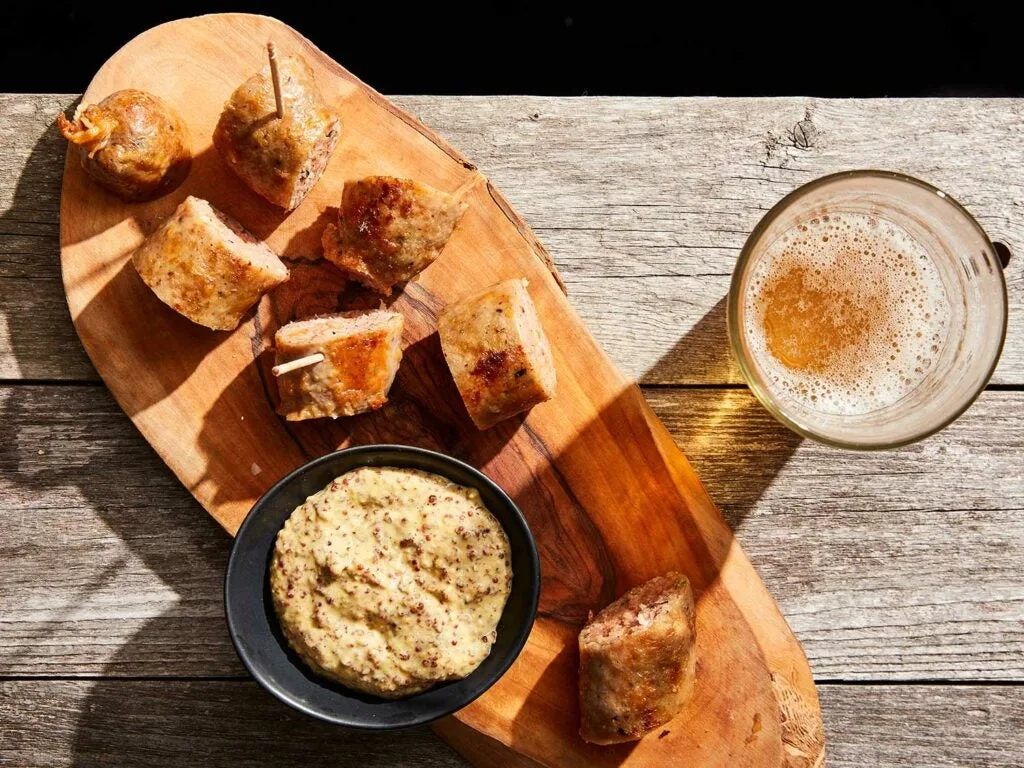
These brats make for a perfect snack before dinner. Photographs by Christopher Testani/Food and Prop Styling by Roscoe Betsill
Ingredients
For the bratwurst spice:
1⁄4 cup black peppercorns
1⁄4 cup fennel seeds
1⁄4 cup coriander seeds
1⁄4 cup white peppercorns
For the sausage:
5 lb. wild boar shoulder
2 lb. pork fatback
1⁄3 cup bratwurst spice
5 Tbsp. kosher salt
1 Tbsp. olive oil
2 oz. garlic, chopped
8 oz. jalapeño, chopped
2 lb. cheddar cheese, diced into 1⁄2-inch cubes
1 lb. shredded American cheese
Hog casings, soaked in water
Directions
1. Make the bratwurst spice: Working in batches, toast all of the ingredients in a sauté pan on medium-low to low heat for about 15 minutes, or until the spices are toasted and fragrant. Remove from heat, allow to cool, and grind the mixture in a spice grinder or with a mortar and pestle. Stored in a jar, this spice mixture will keep for several months.
2. Cut the boar meat and pork fatback into 2-inch cubes. Place the meat into a large bowl, add the bratwurst spice and salt, and mix thoroughly. Let the meat marinate in the refrigerator for at least 2 hours and up to 24 hours.
3. Before you grind the meat, place all of the metal components of your meat grinder and a large bowl in the freezer for about 30 minutes.
4. Grind the meat through a medium die into the chilled bowl. Grind the meat a second time through a fine die. (Note: Depending on how long the first grind takes, you might need to place the metal grinder components back in the freezer for about 15 minutes before you proceed with the second grind.) Once you’re finished, place the meat in the refrigerator to chill.
5. Meanwhile, heat the olive oil in a sauté pan over medium-low heat, and gently cook the garlic and jalapeños until they’re slightly translucent. All you want to do here is reduce the intensity of the ingredients so they don’t overpower the sausage. Remove the garlic-pepper mixture from heat, and set aside to cool.
6. Take the ground meat out of the refrigerator, and add both cheeses and the cooled garlic-jalapeño mixture, and combine thoroughly with your hands.
7. Emulsify the sausage: Add about 2 cups of ice water, a bit at a time, to the meat, and mix vigorously with your hands for 5 to 10 minutes, or until the meat takes on a tacky texture and begins to stick to the sides of the bowl. Cook a small patty of the sausage and adjust the seasoning as needed. Let the meat rest, covered, for an hour in the refrigerator.
8. Stuff the meat into the casings, forming 4- to 5-inch links. Prick any air bubbles in the sausage with the point of a paring knife or toothpick. Place the sausages on a sheet pan and let them sit, uncovered, in the refrigerator overnight. At this point, you can snip the casing between each link, and the sausage can be cooked or frozen.
This sounds great. How should I serve them?
Traditionally, you’d simmer bratwurst in a mixture of beer and onions, which is a killer cooking method. But I prefer mine smoked and then finished on the grill. Serve them on a toasted bun with sauerkraut or grilled onions and peppers and a grainy mustard, or slice the links and enjoy them as a happy-hour snack. A funky cider pairs well with these brats. —J.P.B.
Rabbit Chorizo
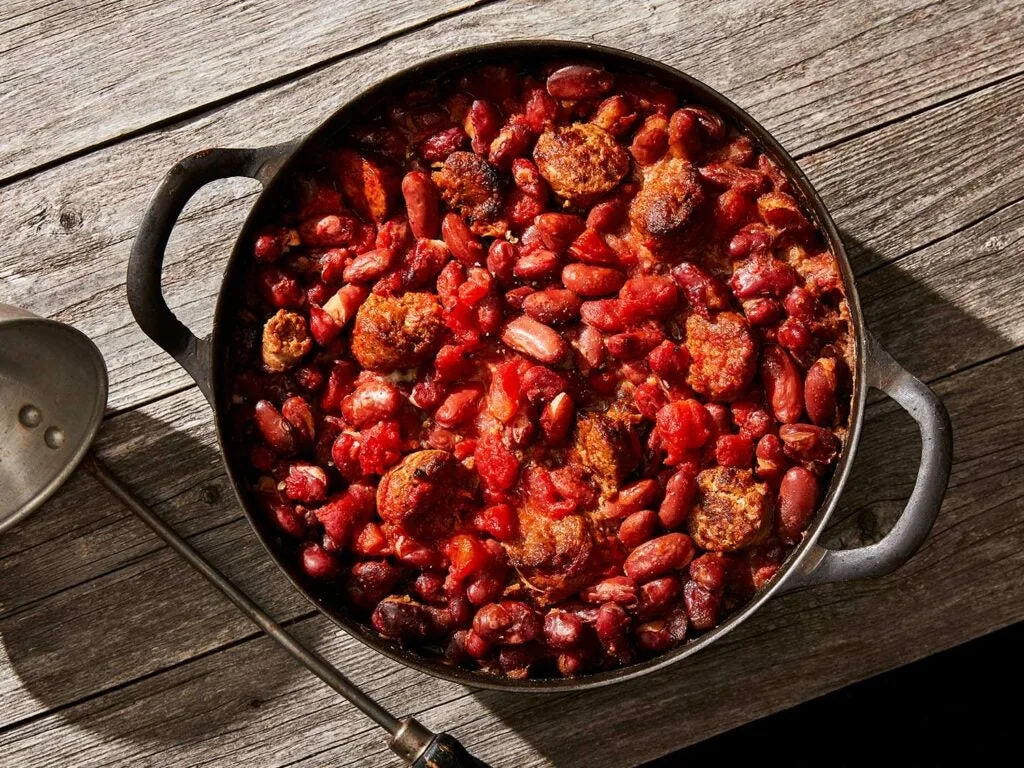
Rabbit chorizo goes perfectly in a big pot of red beans. Serve over rice. Photographs by Christopher Testani/Food and Prop Styling by Roscoe Betsill
Ingredients
5 lb. boneless rabbit meat
3 lb. pork belly
10 garlic cloves, minced
14 Tbsp. ancho chile powder
6 Tbsp. ground cumin
8 Tbsp. ground sweet paprika
5 Tbsp. salt
8 tsp. ground coriander
4 tsp. freshly ground black pepper
4 tsp. dried oregano
2 tsp. dried thyme
3 tsp. ground clove
3 tsp. ground cinnamon
2 tsp. cayenne powder
1 cup apple cider vinegar
Directions
1. Cut the rabbit and pork into 2-inch cubes. Place the meat in a bowl, add the garlic and the dried spices, and mix. Let the meat marinate in the refrigerator for at least 2 hours and up to 24 hours.
2. Before you grind the meat, place all of the metal components of your meat grinder and a large bowl in the freezer for about 30 minutes.
3. Grind the meat through a medium die into the chilled bowl. Add the vinegar to the ground meat, and mix with your hands.
4. Emulsify the sausage: Add 2 cups of ice water, a bit at a time, to the meat, and mix vigorously with your hands for 5 to 10 minutes, or until the meat takes on a tacky texture and begins to stick to the sides of the bowl. Cook a small patty of the sausage and adjust the seasoning as needed. Let the meat rest, covered, for an hour in the refrigerator. Meanwhile, place the metal grinder components back in the freezer.
5. Portion the sausage into 4-ounce balls, and freeze or refrigerate and eat within the next 5 days.
The rabbits are chorizoed, and I’m ready to cook. What should I make?
Chorizo is one of those sausages that is great for any meal. My favorite way to prepare it is folded into eggs and potatoes, and wrapped in a tortilla for a breakfast burrito, or simmered in a pot of red beans and rice for a hearty supper. —J.P.B.
Why It’s Important to Keep a Grinder Cold
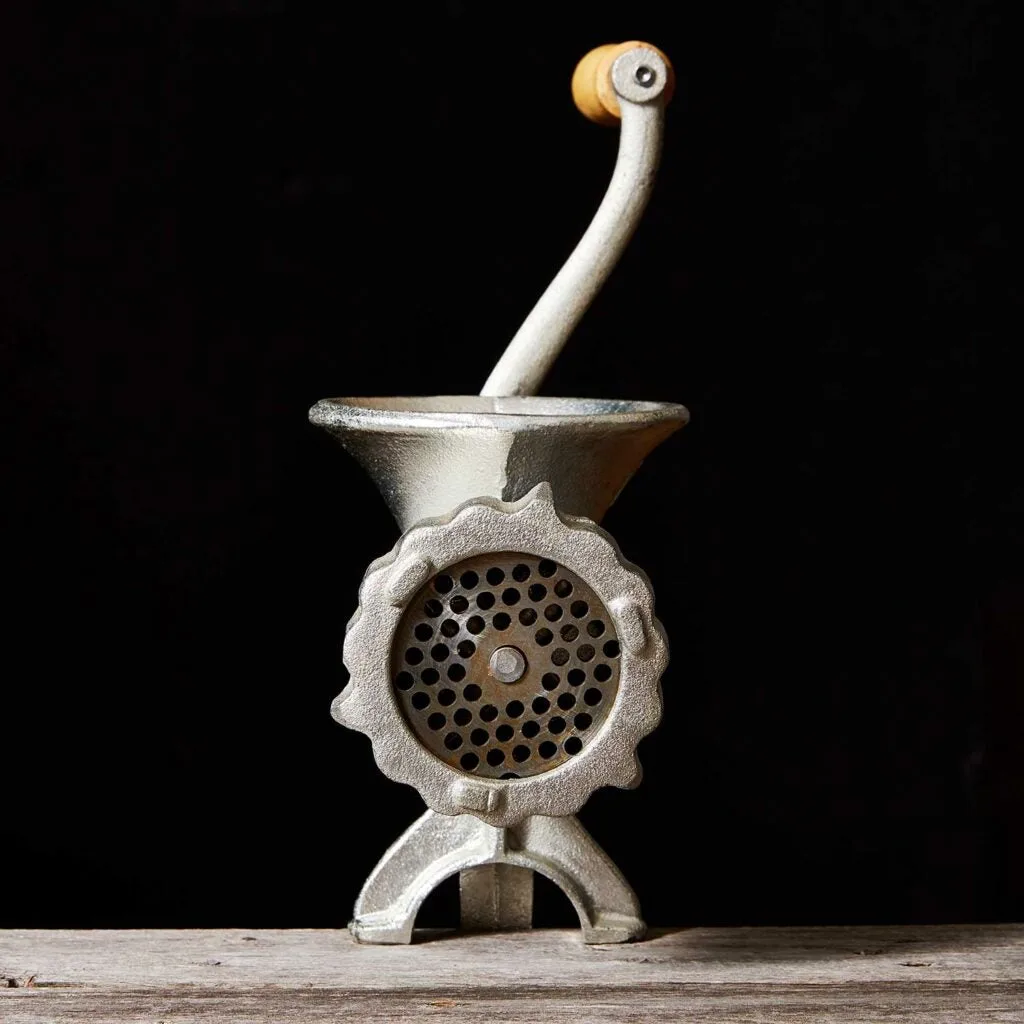
Keep your the metal parts of your meat grinder clean and cold. Photographs by Christopher Testani/Food and Prop Styling by Roscoe Betsill
Really, though—do I have to keep the grinder cold?
Yes! Quit being so lazy.
OK. Why is it so important to do this?
So you don’t get sick, that’s why. There’s a lot of friction that goes on during the grinding process, and that friction causes heat, and bacteria thrive in warm environments. Chilling the metal parts of your grinder—or the entire grinder if you prefer the old-school crank models—will help keep the meat cold, and bacteria-free, during the grinding process.
Got it. What if I have to grind the meat twice, through the medium and fine die—should I rechill the parts in between?
Not necessarily, but be prepared to transition right into the second grind so the grinder parts stay cold.
All this talk about bacteria has me worried. I’m not going to give everyone at camp food poisoning, am I?
No. Just keep the grinder cold while you use it, and clean it after you use it, and you won’t have a problem. In other words: As long as you’re not lazy, you’ll be fine. —J.P.B
What’s the Best Way to Make Perfect Sausage Links?
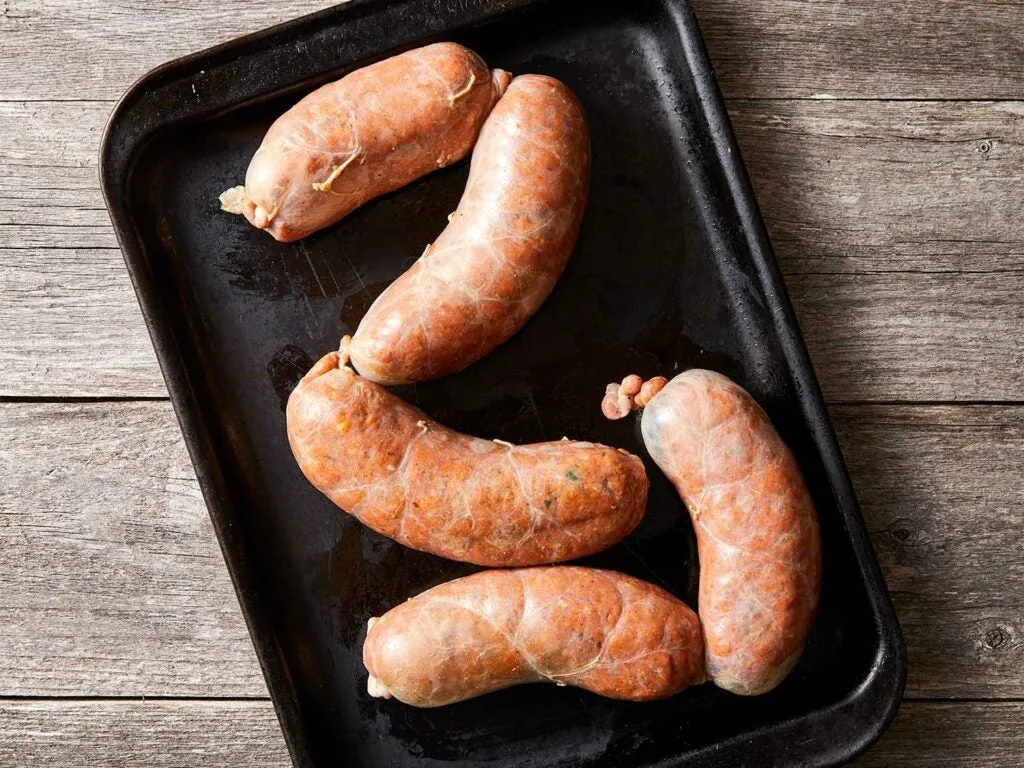
Links of wild game sausage. Photographs by Christopher Testani/Food and Prop Styling by Roscoe Betsill
Why do the sausage links at the butcher shop look so much better than mine?
Because your butcher has more experience than you. The more you do this, the better you’ll get. First, you want to make sure you don’t overstuff the sausage, which is all really a matter of feel. If the casing does burst, just snip it, tie a new knot in the end, and start over. Once the casing is filled, gauge a 4- to 5-inch link and pinch the casing at that spot. Slowly twist the link until the sausage is slightly firm to the touch. When you move on to the next link, twist the sausage in the opposite direction from the previous link. Alternating the twists will keep the links from unwinding. Repeat this until your rope of sausage becomes a chain of links worthy of a butcher-shop window.
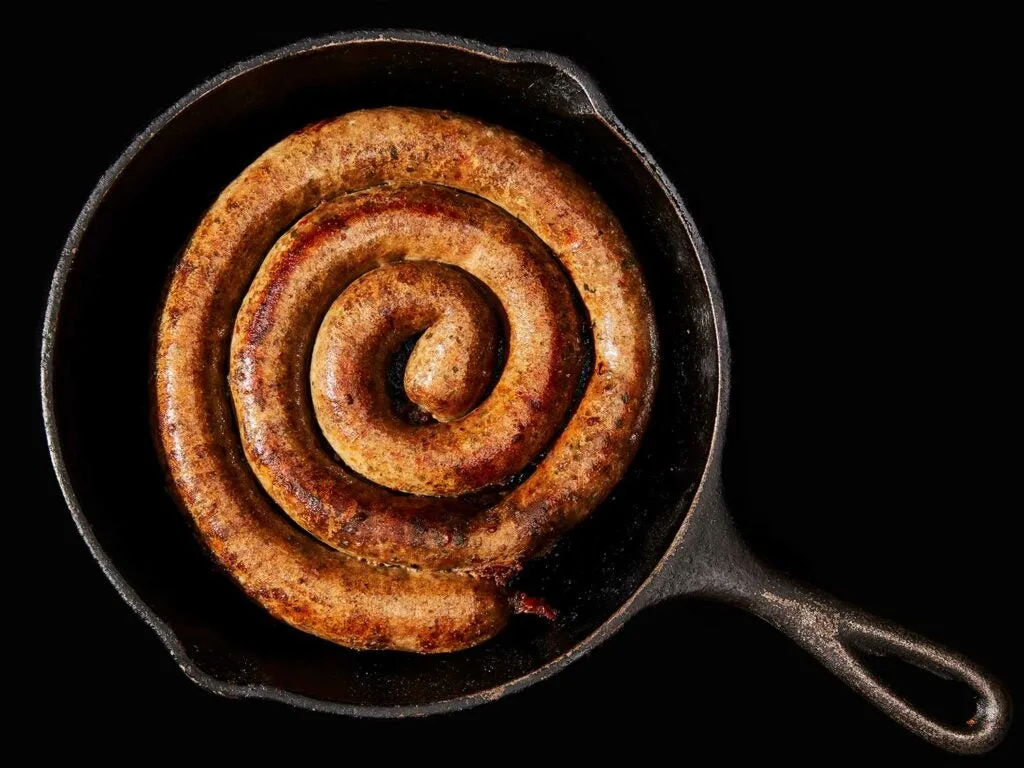
You can skip the links and cook a entire rope of sausage in a cast-iron skillet. Photographs by Christopher Testani/Food and Prop Styling by Roscoe Betsill
This might sound stupid, but is it bad if some links are in your recommended 4- to 6-inch range…and others are 3 or 7 inches?
Doesn’t matter one bit. Cook them all the same. If they fit on a bun, serve them on a bun. If they don’t, slice them up and serve them as a snack. You can’t go wrong. —J.P.G.

